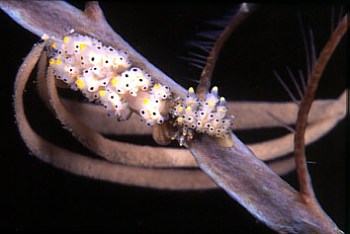
Doto sp. 7
Order: NUDIBRANCHIA
Suborder: DENDRONOTINA
Family: Dotidae
PHOTO
near Berau, East Kalimantan, Indonesia. Depth 23 metres, sandy bottom, in an area with strong currents. Photo: Tony Wu
Authorship detailsRudman, W.B., 2001 (April 5) Doto sp. 7 [In] Sea Slug Forum. Australian Museum, Sydney. Available from http://www.seaslugforum.net/find/dotosp7
Related messages
Doto dunnei? from East Timor
November 4, 2008
From: Brian Francisco
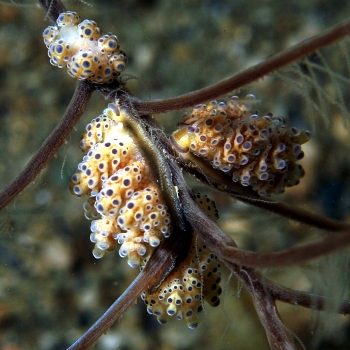
Concerning message #5745:
Hi Bill
Last night we found four Dotidae, along with their egg masses, that look a lot like those depicted in the Doto dunnei factsheet. Although the factsheet refers to species found in the North Atlantic, I suppose it's possible that they are in the Indo-Pacific region as well.
Locality: Tasi Tolu, 18 meters, East Timor, Banda Sea, 30 October 2008, sandy slope. Length: 1 cm. Photographer: Brian Francisco.
Cheers
Brian
francisco.brian@gmail.com
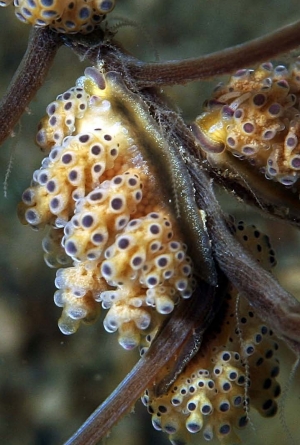
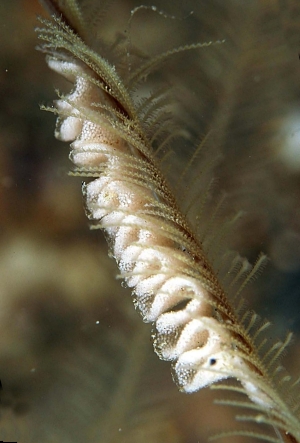
Dear Brian,
There are quite a few species of Doto with black spots at the tips of their ceratal tubercles. While anything is possible, I am not sure if we have good evidence to show that species of Doto are 'tramp' species, sreading worldwide on shipping. My bet is that your animal isDoto sp. 7 . It is on a very similar hydroid with a very wrinkled and thick central stalk. For that matter, perhaps D. ussi, which lives on a similar hydroid is also a non-spotted version of one species?
Best wishes,
Bill Rudman
Re: Doto from Indonesia
July 29, 2008
From: Teresa Zuberbühler
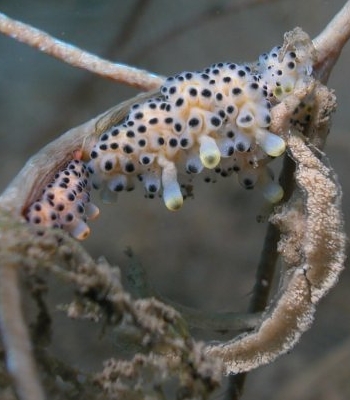
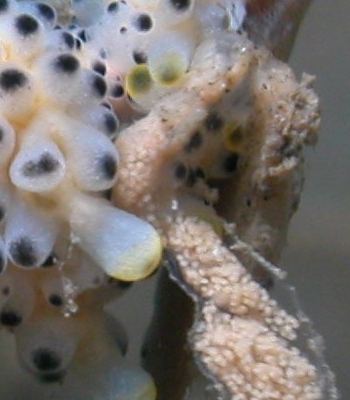
Concerning message #4061:
Dear Bill
Here a photo of Doto sp. 7 laying eggs. Amazing long egg threads! I found the nudibranch on isolated hydroid colonies.
I send you a close-up of the eggs - can't make out if the larger or smaller nudibranch is producing it. Do you know if the larger specimen is the female as is my guess.
On a closer look it is not even clear to me, if they are eating the eggs!!
Locality: Puri Jati, 25 m, Bali, Indonesia, Pacific, August 2006, very fine sand. Length: 7 mm and smaller. Photographer: Teresa (Zubi) Zuberbühler.
Greetings
Teresa Zubi
webmaster@starfish.ch
Teresa Zuberbühler, 2008 (Jul 29) Re: Doto from Indonesia. [Message in] Sea Slug Forum. Australian Museum, Sydney. Available from http://www.seaslugforum.net/find/21609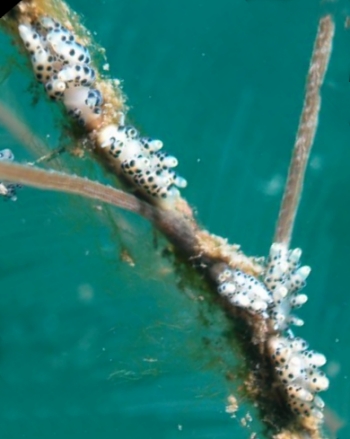
Dear Zubi,
I am afraid what's happening is not clear to me either. I can't be sure if the 'eggs' are nudibranch eggs, but I am pretty sure they are not freshly laid eggs. From your photo it looks like this group of Doto have eaten all the polyps on this hydroid colony. They will either have to move on - and hopefully find another suitable colony - or starve.
Best wishes,
Bill Rudman
Doto sp. 7 from Bali
June 14, 2007
From: Danny van Belle
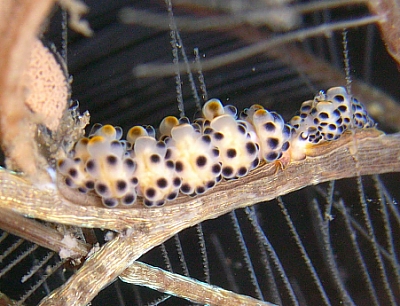
Hello Bill,
This seems like Doto sp. 7 which are seen very regularly on the sandslope at Puri jati in Bali. Depth around 20 meters. It seems that indeed the eggmass is very big. All of them are surrounded with it.
Locality: Puri Jati - Bali, 20 meters, Indoensia, Indian ocean, 16 August 2006, Sandslope with sea pens and some hydroids. Length: 1 cm. Photographer: Danny van Belle.
Danny van Belle
danny.van.belle@skynet.be
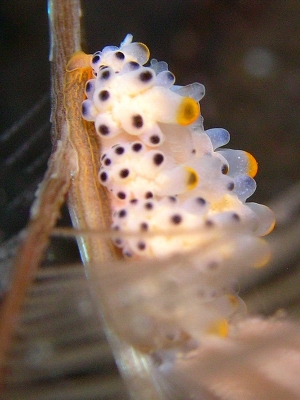
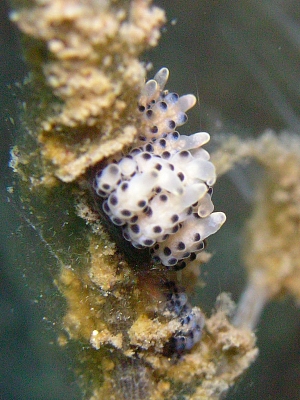
Thanks Danny,
Best wishes,
Bill Rudman
Re: Doto from Indonesia
April 11, 2001
From: Tony Wu
Thank you very much for your help Bill. We didn't witness the actual egg laying event, but these nudibranchs were on this hydroid at this approximate point for about 10 days from the time we found them. The eggs were not there when we found them, and were there when I went back this time to take a look. Fairly strong circumstantial evidence?
Tony
osiris@singnet.com.sg
Wu, T., 2001 (Apr 11) Re: Doto from Indonesia. [Message in] Sea Slug Forum. Australian Museum, Sydney. Available from http://www.seaslugforum.net/find/4162Dear Tony,
I'm afraid your evidence is not that strong. It's equally possible that something else visited when you were not there and deposited the egg mass. I suspect the egg mass is very large for the size of your Doto. A small animal like Doto would attach its egg mass firmly to the substrate or some solid surface. Your egg mass seems to be attached only at odd intervals. I can't see how a Doto of this size could crawl between the attachment points while it was laying the egg mass. It would need to crawl over a solid surface. I suspect the eggs were layed by a much larger animal which could stretch out from one algal 'branch' to the next - but that's only my considered opinion, I could be quite wrong.
Cheers,
Bill Rudman
Doto from Indonesia
April 7, 2001
From: Tony Wu

Dear Bill,
I write and photograph for Asian Diver magazine in Singapore, and Sportdiving magazine in Australia. I am in the process of publishing a collection of marine photos, and I was wondering if it would be possible to ask for some help in identifying a few images of nudibranchs.
The attached image is from the waters near Berau in East Kalimantan, Indonesia. The depth was 23 metres, sandy bottom, in an area with strong current. The nudibranchs appear to have mated and laid long egg masses which appear in the background, flowing with the current. They are on a hydroid-like organism.
I can't seem to find these in any of my guide books. Thanks very much for any guidance you can offer.
Best regards,
Tony
osiris@mbox2.singnet.com.sg
Wu, T., 2001 (Apr 7) Doto from Indonesia. [Message in] Sea Slug Forum. Australian Museum, Sydney. Available from http://www.seaslugforum.net/find/4061Dear Tony,
This is a species of Doto. It has similarities to two species described from Japan, Doto japonica and Doto bella which both have a black spot at the tip of each ceratal tubercle. However neither has been reported to have the ceratal tip capped in yellow like your animal. It is possible the egg masses in the background belong to this Doto but unless you actually see them producing them you can never be sure. Another nudibranch could have been past in the last few days and decided that this was a nice spot to lay some eggs.
Species of Doto look and behave very much like aeolids. They have aeolid-like cerata and they feed on hydroids like many little aeolids. They are however more closely related to the soft-coral feeding tritoniids. Unlike aeolids they do not have cnidosacs at the tip of their cerata to store nematocysts from their cnidarian prey.
Best wishes,
Bill Rudman
